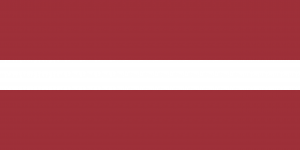Language/Standard-latvian/Grammar/Gender
Hi Standard Latvian learners! 😊
In this lesson, we will cover one of the essential aspects of Standard Latvian grammar - Gender. Gender is a crucial concept in many languages, including Latvian, and can significantly affect how you speak and write in this language. Understanding gender is essential to speak and write fluently in Standard Latvian. Let's get started!
Don't hesitate to look into these other pages after completing this lesson: 0 to A1 Course & The subjunctive mood and wishes.
What is Gender in Standard Latvian?[edit | edit source]
Gender is a grammatical category used to classify nouns, pronouns, and adjectives in Standard Latvian. There are only two genders in Standard Latvian: masculine and feminine. Each noun in Standard Latvian is assigned to a gender category. The gender of a noun can affect how the article is used, how adjectives are formed and declined, and how the verb agrees with the noun.
Gender Categories in Standard Latvian[edit | edit source]
In Standard Latvian, there are two gender categories: masculine and feminine. The gender of a noun often correlates with the natural gender of the objects they refer to; however, this is not always the case. Inanimate objects, for example, may also have a gender category.
Here are some examples of gender categories in Standard Latvian:
| Standard Latvian | Pronunciation | English |
|---|---|---|
| vīrietis | [ˈviː.ɾi.e.tis] | man |
| sieviete | [ˈsie.vi.e.te] | woman |
| suns | [suːns] | dog |
| kaķis | [ˈkaː.t͡ʃis] | cat |
How to Identify the Gender of a Noun[edit | edit source]
To correctly use gender in your Standard Latvian grammar, you must first identify the gender of each noun. As mentioned earlier, a noun's gender does not always correspond to the natural gender of the object referred to. Therefore, it is essential to use appropriate articles and pronouns to correctly convey the gender.
Here are some rules to help identify the gender of a noun:
1. Masculine nouns often end in -s, -is, -us, -ītis, and -onis.
Example: vīrietis (man)
2. Feminine nouns often end in -a or -e.
Example: sieviete (woman)
3. Some nouns are inanimate but still fall into either the masculine or feminine gender category. When in doubt, check the dictionary or ask a native speaker.
Example: saule (sun) is a feminine noun, whereas dārzs (garden) is a masculine noun.
It is essential to identify the gender of a noun in Standard Latvian to use it correctly in sentence construction.
How Gender Affects Sentence Structure in Standard Latvian[edit | edit source]
Gender plays an essential role in sentence structure in Standard Latvian. Using the wrong gender can affect the meaning of sentences and make them difficult to understand. Here are some of the ways in which gender affects sentence structure:
Articles[edit | edit source]
In Standard Latvian, like many other languages, the use of articles is essential when conveying gender. In Latvian, the masculine article is "viens", and the feminine article is "viena".
Example:
- Masculine: Viens vīrietis skrien pa ielu. (A man is running down the street).
- Feminine: Viena sieviete brauc ar velosipēdu. (A woman is riding a bicycle)
Adjectives[edit | edit source]
Adjectives in Standard Latvian decline based on gender. For example, the adjective "liels" (big) has different forms for masculine and feminine:
| Standard Latvian | Pronunciation | English |
|---|---|---|
| liels viens vīrietis | [liels viː.ɛns ˈviː.ɾi.e.tis] | one big man |
| liela viena sieviete | [liɛla viɛna ˈsie.vi.e.te] | one big woman |
Verbs[edit | edit source]
In Standard Latvian, the verb must agree with the noun's gender in number (singular or plural) and person (first, second or third). For example:
- Masculine: Vīrietis skrien pa ielu. (The man is running down the street).
- Feminine: Sieviete brauc ar velosipēdu. (The woman is riding a bicycle).
Dialogue[edit | edit source]
Person 1: Vai tu esi redzējis jaunu kucei? (Have you seen a new puppy?) Person 2: Jā, esmu redzējis mazu brūnu kucēnu. (Yes, I have seen a small brown puppy.)
Tips to Improve Your Standard Latvian Gender Grammar[edit | edit source]
To improve your grammar, you can also use the Polyglot Club website. Find native speakers and ask them any questions! Additionally, you can review the entire Standard Latvian Grammar section for more lessons and exercises.
Sources[edit | edit source]
➡ If you have any questions, please ask them in the comments section below.
➡ Feel free to edit this wiki page if you think it can be improved. 😎
Other Lessons[edit | edit source]
- Conditional Mood
- Negation
- Pronouns
- Future Tense
- Give your Opinion
- How to Use Be
- Nouns
- How to Use Have
- Adjectives

